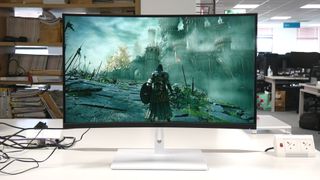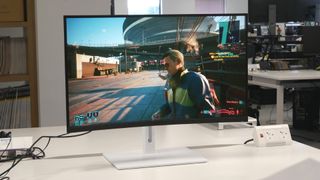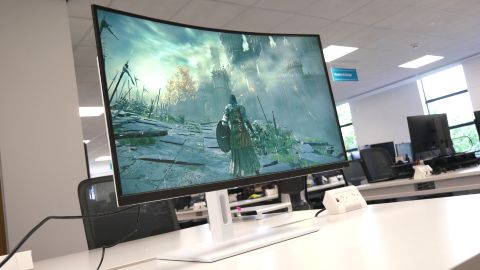Our Verdict
NZXT’s first curved 32-inch gaming monitor is a fine physical specimen in terms of styling, engineering, and build quality. The actual gaming experience doesn’t exactly break new ground. But there’s decent response, plus the usual low-latency upsides of 165Hz. All told this is a solid offering that’s worthy of anyone’s 1440p SDR shortlist.
For
- Nice design and engineering
- Decent response for a VA panel
- Useful CAM software
Against
- Very limited HDR experience
- Not very punchy
- Curved panel doesn’t add much
PC Gamer's got your back
PC cases or even fully built PCs. That’s the stuff for which we know NZXT best. But monitors? Not so much. Enter the new NZXT Canvas 32Q Curved. It’s a 32-inch, 1440p and 165Hz panel that begs an immediate question. When it comes to gaming monitors, is it better to have something from a screen specialist, for instance LG, that’s then been optimised for gaming? Or can a gaming specialist apply their know-how to screens? Time to find out.
In terms of headline specs, the NZXT Canvas 32Q Curved is nothing exceptional. It’s good, to be sure. But a 32-inch VA panel with 1440p resolution, 165Hz refresh, 1ms response, and 300nits of brightness is not setting new standards. Instead, it’s joining the fray with competitive but not world-beating specs.
Speaking of specs, NZXT’s own numbers rate this VA panel at a mere 1,000:1 static contrast. You’d normally expect at least 2,000:1 if not 3,000:1 from a modern VA panel. The 1ms response claim is also said to be via the grey-to-grey metric rather than MPRT. Only Samsung has previously managed a VA monitor with 1ms GT rather than MPRT, previously. Curious.
For the record, the NZXT Canvas 32Q Curved does support HDR10 signal processing. But with that 300nits maximum brightness and no local dimming, well, you know the drill. This isn’t true HDR or even close to it. Nor is the panel hugely colour accurate. NZXT rates the 32Q at 89% of the DCI-P3 gamut and 99% of sRGB. Both numbers are a little off the pace compared to a decent IPS panel. But in a gaming context, that’s not a huge issue.
What the Canvas 32Q is, however, is curved to the tune of 1500R which is a fairly substantial bend. Curved screens are subjective at the best of times. But we think most people would agree they make more sense with ultrawide panels than a more conventional 16:9 monitor like this. For sure it doesn’t detract from the experience much. But nor does curvature unambiguously improve this display.

Screen size: 32-inch
Panel type: VA
Resolution: 2,560 x 1,440
Brightness: 300nits
Contrast: 1,000:1
Response time: 1ms
Refresh rate: 165Hz
Colour coverage: 89% DCI-P3
HDR support: HDR10
Adaptive sync: FreeSync Premium, G-Sync Compatible
Connectivity: DisplayPort 1.2 x1, HDMI 2.0 x2, USB Type-C
Price: $429 | £469
Anyway, if the Canvas 32Q Curved mostly seems pretty mainstream, where does the NZXT goodness come in? First, there’s the design. This is a fantastic looking display. And it’s beautifully built, too. The main enclosure is high-quality white plastic while the metal stand is very nicely engineered.
The stand adjusts for swivel, tilt, and height, but not rotation into portrait. It’s also, strictly speaking, an optional extra. In the US the NZXT Canvas 32Q Curved clocks in at a fairly competitive $379 without the stand and $429 with it, while in the UK it’s £429 without and £469 with, which is a little pricey. Anyway, it’s an interesting twist, being able to option the stand. Forgo it and the screen offers VESA 100mm by 100mm mounting support and indeed NZXT will also sell you single and double-mount VESA arms to that end as an alternative to the factory stand.
Beyond that, the other obvious NZXT-specific feature is the CAM software. Essentially, it’s a Windows app alternative to clunky monitor OSD menus. Not that NZXT’s OSD is particularly clunky. It’s actually quite slick, as OSD’s go. But the CAM app is more powerful and configurable, allowing you to control the various features and settings without needing to use the OSD, including making settings profiles on a per-app basis.
Inputs wise, you get HDMI, DisplayPort and USB Type-C with DisplayPort alt mode. Just note that the latter does not support power delivery. So you can’t have single cable connectivity to a laptop and both drive the display and charge the lappy. That said, the 165Hz is available over the USB, in case you were wondering.

Anywho, what to make of the actual image quality? Obviously, you need to be comfortable with the fairly fat pixels that come with a 32-inch panel and 1440p native resolution. A crispy 4K monitor this is not. That’s much more of an issue on the Windows desktop than it is in-game. But it does compromise the appeal in all-around, multi-usage terms.
Moreover, this is not a monitor that immediately socks it to you. For a VA panel, it’s not hugely contrasty, the viewing angles are OK rather than great. Moreover, as you would expect from a maximum brightness of 300 nits, it’s simply not massively punchy in outright terms. Dare we say it, it has a slightly old-fashioned feel and lacks the saturation and zing of the very best current panels.
As for pixel response, there are three levels of overdrive available and even the fastest setting is very usable, with little by way of visible overshoot or inverse ghosting. Perhaps not altogether surprisingly, as a consequence of the relatively restrained overdrive the 32Q doesn’t look as sharp and zippy as the best current IPS panels. It’s just that little bit softer with fast motion.











Inevitably, HDR performance is not a highlight either. This panel lacks the brightness and backlight modulation required for that. It’s also worth noting that the gamma of SDR content is a bit wonky with the panel running in HDR mode in Windows. So, you absolutely wouldn’t want it in HDR mode unless you were specifically watching or playing HDR content.
Not that we would bother with HDR mode in general. Compare an HDR-heavy title like Cyberpunk 2077 in SDR and HDR mode on this display and you’d be hard pressed to say which was which.
All of which probably seems rather negative. But this is not a bad monitor. For the most part, it performs pretty much as you would expect given the specs. It’s a 300nit, 165Hz, 1440p (essentially) SDR gaming panel. It’s probably not as contrasty as you might expect from a VA monitor. The response isn’t quite as good as the best IPS screens. But it is by no means a smeary mess. It’s pretty quick. And it looks great and is built very nicely.
So, it’s not a bargain, the NZXT Canvas 32Q Curved. Nor is it flawless or a world-beater. But it is a solid option in this part of the market.
If we were shopping 32-inch, 165Hz, 1440p, SDR panels, it would be a case of deciding whether we thought the styling and engineering upsides of this NZXT offset the slightly more vibrant image quality of some of the alternatives. So, yeah, there are definitely some things that NZXT is doing better than the established monitor makers. But the company also has a little more to learn before it has the full measure of the big brands.
NZXT’s first curved 32-inch gaming monitor is a fine physical specimen in terms of styling, engineering, and build quality. The actual gaming experience doesn’t exactly break new ground. But there’s decent response, plus the usual low-latency upsides of 165Hz. All told this is a solid offering that’s worthy of anyone’s 1440p SDR shortlist.

Jeremy has been writing about technology and PCs since the 90nm Netburst era (Google it!) and enjoys nothing more than a serious dissertation on the finer points of monitor input lag and overshoot followed by a forensic examination of advanced lithography. Or maybe he just likes machines that go “ping!” He also has a thing for tennis and cars.
